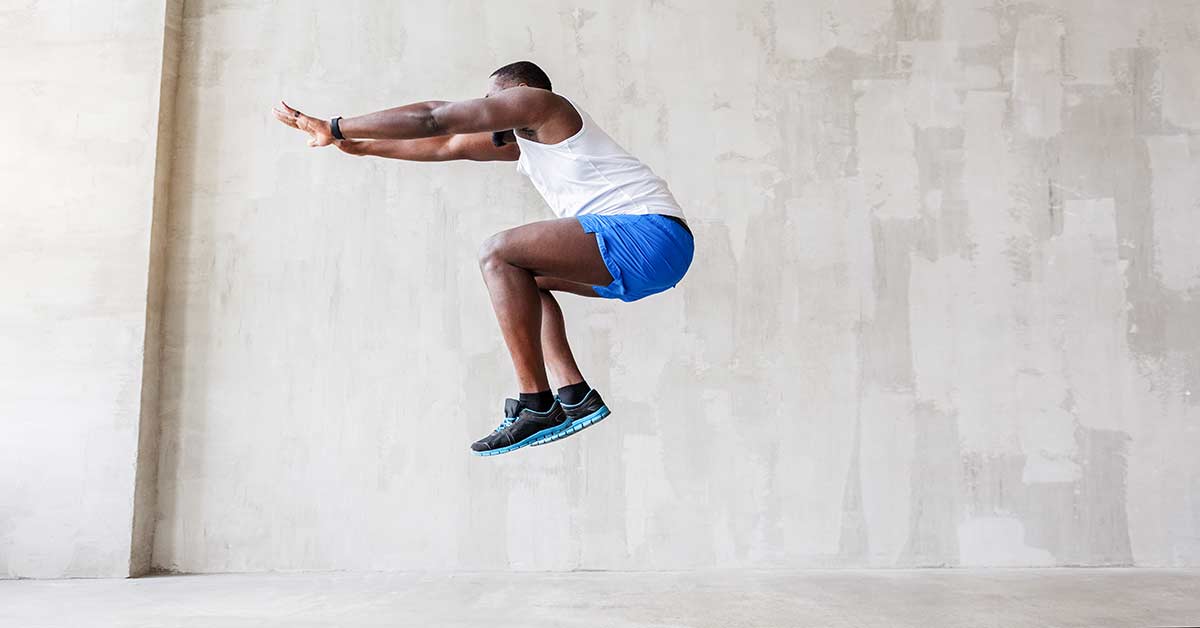Plyometrics are exercises that only use the weight of your body and gravity. It consists primarily of jumping and rapid movement for short bursts of time. This type of training is done by most athletes and anyone who wants to quickly enhance their lung strength. These exercises target the entire body with a heavy focus on legs and abs.
Plyometrics training is fantastic for cardiovascular health but will also increase muscle and tone quickly. These exercises are so effective that you don’t even need to do long sessions to achieve results. Only 30 minutes a day for 4 days a week is enough to see some serious results. Some examples of plyometric exercises are:
- Burpees
- Squat Jumps
- High Knees
- Plank to Frogger
- Pistol Squat
- Lunge Jump
- Skater Shuffle
Pros:
Strength
Endurance
Fat-loss
Speed
Coordination
Cons:
Longer Recovery
High-impact
Injury Risk
Pros:
Strength
Plyometrics training heavily relies on lower body strength and an activated core. Leaping and quick horizontal movements that require lots of leg activation, build strength and muscle density. Training that focuses on the lower body quickly raises the heart rate since legs are the largest muscle group in the body. Strong legs enhance running and also help support the lower back.
Endurance
Heart and lung strengthening exercises increase blood flow and help the body be more efficient at regulating breathing. Plyometrics is one of the fastest ways to increase endurance, lung strength, promote mental health and aid in weight loss.
Fat loss
Short bursts of high-intensity activity followed by a rest period and then repeated, are how to fire up any metabolism. This results in greater fat loss as the body continues to burn fat well long after the session has ended. Risks for health issues such as cardiovascular disease, joint pain, high blood pressure, and diabetes are all significantly reduced with fat loss. Surprisingly, fat loss also balances hormones, improves sleep and reduces stress.

*Pro Tip* – Plyometrics benefits anyone training for a marathon as adding it to your routine will enhance speed, endurance, and mobility.
Speed/Agility
Since routines are performed in sets, you are forced to move quickly from one exercise to another and you learn to maneuver swiftly and lightly. This improves balance as well as the connection between mind and body. You will find yourself fundamentally more stable at activities such as jumping rope, running, dancing and even walking.

Coordination
Jumping from one point to another increases coordination and enhances the depth perspective. You will find yourself with overall better athletic abilities in activities such as tennis, boxing, basketball, and golf. Coordination benefits you at the office as well since it results in faster and more accurate typing skills.
*Pro Tip*- When beginning plyometrics training make sure to take at least two days off between sessions. This allows your body enough time to recover and helps prevent injury.
Cons:
Longer Recovery
Plyometrics causes a greater amount of strain on the body because of the nature of the exercises. This strain requires a longer recovery period and can also lead to burnout. It is important to listen to your body and not push it beyond your physical limits. It is recommended to take a two day rest period between sessions to fully allow healing and muscle growth.
High-impact
Plyometrics is a high impact activity and this has positive but also negative effects on the body. So keep in mind that maintaining proper form and wearing correct shoes is key. Any high-impact exercise routine affects joints, knees, and ankles. If you have any of these issues, then try swimming, walking or elliptical training instead.

Injury Risk
Since jumping is the main action of plyometrics there is a higher risk of injury especially when box jumping is involved. Maintaining the correct form is very important in reducing the risk of injury. If you are unsure how to correctly perform plyometric exercises you should seek out a personal trainer. Another option is to study some videos and test out the exercises in front of a mirror so you can correct yourself accordingly.
The Verdict
The pros definitely outweigh the cons of plyometrics training. However, that does not mean plyometrics is the right workout for you. Take into consideration your current fitness level and also your future goals. You need to find a way to reach your goals in a comfortable and engaging way. Try out a few of the top plyometrics exercises and see if it is something you enjoy and can begin to incorporate into your daily routine. Consult your doctor and/or personal trainer if you are unsure.



